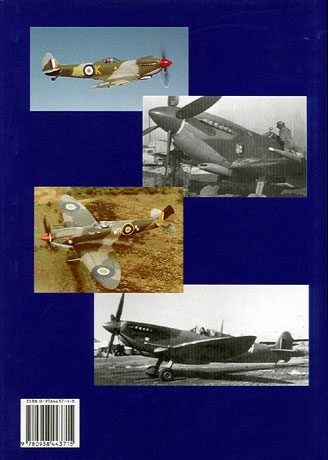|
S u m m a r y
|
| ISBN: |
Not quoted |
| Media: |
224 pages, hardback cover |
| Price: |
ZAR 300 |
| Review Type: |
First Read |
| Advantages: |
Good coverage of history and
operations plus post-war fate of SAAF Spitfires; plenty of photos
and profiles. |
| Disadvantages: |
|
| Recommendation: |
Recommended |
Reviewed by
Sinuhe Hahn & Piet van Schalkwyk

HyperScale is proudly supported by Squadron.com
It is with pleasure that we can report on a new book that faithfully
documents the history of the Spitfire in service with the South African
Air Force (SAAF) down to the list of serial numbers and their individual
history. What is even more pleasing is that it even includes a few
highlights that we were unaware of.
Indeed, we are so impressed with this volume that we would like to
attract the attention of other Spitfire fans to it. Hopefully, they will
become SAAF enthusiasts in the process.
 Author Steven McLean has taken considerable pains to trace the
history of the ten SAAF squadrons that flew Spitfires during WWII,
starting with the Mk. Vb's of 1 Squadron in November 1942. This unit had
previously flown Hurricanes. The next was 40 Squadron, who operated
their Mk.Vbs in a tactical reconnaissance role, using an oblique camera
installed behind the cockpit. These are probably the best known of all
SAAF Spitfires, and they are illustrated by several fine colour photos.
These aircraft are quite distinctive due to their red/white WR Squadron
codes, yellow leading edges and SAAF roundels complete with orange
centers, and on some aircraft, azure blue gun patches. Author Steven McLean has taken considerable pains to trace the
history of the ten SAAF squadrons that flew Spitfires during WWII,
starting with the Mk. Vb's of 1 Squadron in November 1942. This unit had
previously flown Hurricanes. The next was 40 Squadron, who operated
their Mk.Vbs in a tactical reconnaissance role, using an oblique camera
installed behind the cockpit. These are probably the best known of all
SAAF Spitfires, and they are illustrated by several fine colour photos.
These aircraft are quite distinctive due to their red/white WR Squadron
codes, yellow leading edges and SAAF roundels complete with orange
centers, and on some aircraft, azure blue gun patches.
The book also records combat exploits including the massacre of
several Me 323 and Ju52 transports flights, and follows the progress of
the war from North Africa to Kos, Sicily and finally Italy, during which
time the Spitfire MkVIII and MkIX were introduced into SAAF service,
both in the reconnaissance, ground attack and high-altitude interceptor
roles.
Considerable attention is also focussed on the use of 136 Spitfire Mk
IX's which were used by the SAAF in the postwar years, including the
important role they played familiarising pilots with rockets and bombs
prior to their departure for the war in Korea, and culminates with their
retirement in1954.
The author is also to be lauded on tracing the current whereabouts of
ex-SAAF Spitfires including two airframes which are being rebuilt in
Australia, or flying in the UK, US, Canada or Brazil (ex-WR-RR/ Evelyne).
Of interest to modellers are the numerous camouflage schemes, some of
which we have not seen documented in photographic form before, such as
the all blue MkVc's operated from Sicily or the post war MkIX's in their
natural metal finish. These are complemented by a series of colour
profiles.
All in all, this will be a very welcome addition in the hands of
every Spitfire and SAAF enthusiast. Copies can be purchased from www.aviationshop.co.za
; we are not aware of an overseas agent at the moment.
Review Copyright © 2002 by Sinuhe
Hahn & Piet van Schalkwyk
This Page Created on 08 January, 2002
Last updated
22 July, 2003
Back to
HyperScale Main Page
Back to
Reviews Page |
Home | What's
New | Features
| Gallery |
Reviews | Reference
| Forum
| Search